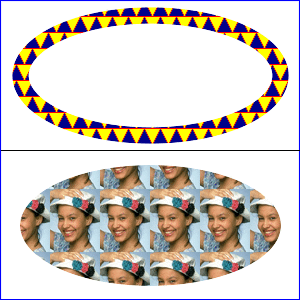class RVG::Pattern < Object
Table of Contents
class methods
instance methods
shared methods
In addition to the methods listed above, this class also implements the
styles method, the shape methods and the transform methods.
class methods
new
RVG::Pattern.new(width=0, height=0, x=0, y=0) [
{ |pattern| drawing method calls } ] ->
pattern
Description
Creates a pattern that can be used with the :fill and :stroke styles.
Define the pattern in the associated block. The pattern can be composed of shapes, text,
raster images, groups, and RVG objects. You can use the
use method to include graphic objects in the pattern.
Arguments
- width, height
- These arguments define the pattern viewport.
- x, y
-
Specify the starting offset of the pattern. The pattern will be repeated at x
+m*width and
y+n*height offsets.
Example

instance methods
g
pattern.g [{|grp| ...}] -> group
Description
Calls RVG::Group.new to construct a group and adds it to the pattern. Yields to a block if one is present, passing the
new group as an argument.
Returns
Returns the new group, so RVG::Group methods can be chained to this method.
image
pattern.image(raster_image, width=nil, height=nil,
x=0, y=0) -> image
Description
Calls RVG::Image.new to construct an image and adds it to the pattern.
Returns
Returns the new image, so RVG::Image methods can be chained to this method.
preserve_aspect_ratio
pattern.preserve_aspect_ratio(align, meet_or_slice='meet') [{|self| ...}] -> self
Description
If you use the viewbox method and the user coordinate system does not scale uniformly to the default coordinate system, use the
preserve_aspect_ratio method to specify whether or not the content is stretched to fit. If not, you can specify how to fit the content into
the space.
Preserve_aspect_ratio yields to a block if one is present, passing self as an argument.
Arguments
- align
-
When the value of the
meet_or_slice argument is 'meet' or 'slice', this argument controls the placement of the content within the
viewport. The align argument is the concatenation of an x-alignment and a y-alignment. The values are shown in these
lists:
x-alignment
- xMin
- align the minimum x value of the content with the left corner of the viewport.
- xMid
- vertically center the content within the viewport.
- xMax
- align the maximum x value of the content with the right corner of the viewport.
y-alignment
- YMin
- align the minimum y value of the content with the top of the viewport.
- YMid
- horizontally center the content within the viewport.
- YMax
- align the maximum y value of the content with the bottom of the viewport
- meet_or_slice
-
This argument can have one of these three values:
- 'none'
- The content is scaled as necessary so that it fits exactly within the viewport. The aspect ratio is not maintained.
- 'meet'
-
The content is scaled as necessary so that the larger dimension exactly fits the viewport. There may be some unused space in the viewport. The
aspect ratio is maintained.
- 'slice'
-
The content is scaled as necessary so that the smaller dimension exactly fits the viewport. Some of the content in the larger dimension may be cut
off. The aspect ratio is maintained.
Example
See the RVG class
example.
Returns
Self, so other RVG::Pattern methods can be chained to this method.
See Also
viewbox
rvg
pattern.rvg(width, height, x=0,
y=0) [{|new_rvg| ...}] -> pattern
Description
This method constructs a new RVG object and adds it to the pattern. Each nested RVG object can use the
viewbox method to define its own coordinate system. The rvg method yields to a block, passing the nested
RVG object as an argument. Within the block, any drawing objects added to the nested RVG object are rendered within the nested RVG object's viewport.
Arguments
- width, height
- Specifies the viewport width and height. The units are in the user coordinate system of the parent container.
- x, y
- The x- and y-axis offsets of the viewport upper-left corner. The units are in the user coordinate system of the parent container.
Example
See the example for
preserve_aspect_ratio in class RVG.
Returns
The RVG object, so other RVG methods can be chained to this method.
text
pattern.text(x=0, y=0, text=nil) [{|text| ...}] -> text
Description
Calls RVG::Text.new to construct a text object and adds it to the pattern. Yields to a block if one is present, passing
the new text object as an argument.
Returns
The RVG::Text object, so other RVG::Text methods can be chained to this method.
use
pattern.use(obj, x=0, y=0,
width=nil, height=nil) -> use
Description
Calls RVG::Use.new to constructs a use object and adds it to the pattern.
When the referenced argument is an RVG object,
width and height can be used to specify the width and height of the viewport. If present and non-nil,
these arguments override any width and height specified when the RVG object was created. You must specify the viewport size either when creating the RVG
object or when referencing it with use.
Examples
See RVG::Use.new
Returns
The RVG::Use object, so other RVG::Use methods can be chained to this method.
viewbox
pattern.viewbox(min_x, min_y, width,
height) [{|self| ...}] -> self
Description
The area of the pattern is called the viewport. By default the origin of the coordinate system for an pattern is (0,0). The user coordinates
are pixels and the width and height are established by the width and height arguments to
RVG::Pattern.new.
Use the viewbox method to superimpose a user coordinate system on the viewport. The viewbox method lets you set up a
coordinate system using the units of your choice.
The viewbox method yields to a block if one is present, passing self as an argument.
Arguments
- min_x, min_y
- The minimum x-coordinate and y-coordinate of the user coordinate system.
- width, height
- The width and height of the user coordinate system.
Example
See the example for the RVG class.
Returns
Self, so other RVG::Pattern methods may be chained to viewbox.
See Also
preserve_aspect_ratio
